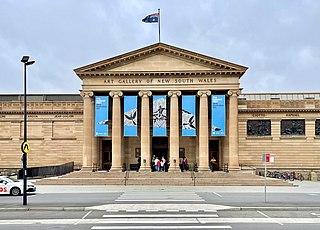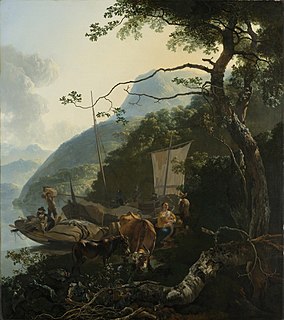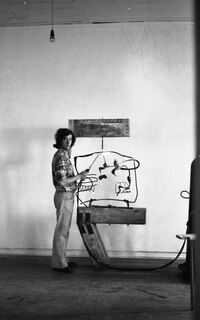Richard Goodwin (born 1953 in Sydney) is an Australian artist, architect and professor of Fine Arts and Design at the University of New South Wales School of Art and Design. [1]
Richard Goodwin (born 1953 in Sydney) is an Australian artist, architect and professor of Fine Arts and Design at the University of New South Wales School of Art and Design. [1]

Goodwin is the director of Richard Goodwin Pty Ltd, a Sydney-based practice that has evolved from performance art to sculpture, installations, parasitic architecture and freeway infrastructure. Goodwin's artwork is held in major collections including the Art Gallery of NSW, Sydney and regional galleries across Australia. [2] He regularly consults on major infrastructure projects such as bridges and freeway walls.
Goodwin's core agenda is creating what he calls "porosity". He argues, "Security seeks to close a city down. Porosity seeks to open it up. Somewhere between the two a solution must be found within our capitalist system. If we can't find the balance, they'll close the cities and cities will die". [3] In practicing this agenda, he tests the functional and aesthetic boundaries of public space through both art and architecture. He has opened up new dimensions in the planning of urban spaces and the way architecture interacts with its physical and cultural context.
In 1996, Goodwin established the Porosity Studio at COFA . The studio enquires into the way patterns of inhabiting and moving through the cities weaves a level of political richness into the fabric of architecture. [4] Since 2004 the studios have been supported by a number of cooperations such as the British Council. They have been run as intensive workshops internationally in cities such as Glasgow, Cardiff, Milan, Beijing and Rotterdam. [5]
The Australian Research Council (ARC)'s prestigious Discovery Grant [6] was awarded to Goodwin in 2002. The research project argued for 'Porosity' as a way of describing an urban experience which turns the building inside out and de-emphasises the obsession with facades. The outcome of the research opened up an entire new chapter in the way the fabric of the city is viewed by civic authorities. The ARC awarded Richard Goodwin again in 2009 with a Linkage Grant to develop the research further through sensors and gaming engine technologies in collaboration with Russell Lowe and the Emergency Information Coordination Unit (EICU) run under the NSW Department of Lands. [7]
Goodwin is the author of Porosity: the Architecture of Invagination [8] and has published many articles on issues of public space, [9] and chapters in collected works. [10] Moreover, a number of articles [11] and books [12] have been published on his work.

RMIT University, officially the Royal Melbourne Institute of Technology, is a public research university in Melbourne, Australia.

The Art Gallery of New South Wales (AGNSW), founded as the New South Wales Academy of Art in 1872 and known as the National Art Gallery of New South Wales between 1883 and 1958, is located in The Domain, Sydney, Australia. It is the most important public gallery in Sydney and one of the largest in Australia.

The National Art School (NAS) is a tertiary level art school, located in Darlinghurst, an inner-city suburb of Sydney, New South Wales, Australia. The school is an independent accredited higher education provider offering specialised study in studio arts practice across various disciplines.

Sam Leach is an Australian contemporary artist. He was born in Adelaide, South Australia. Leach worked for many years in the Australian Tax Office after completion of a degree in Economics. He also completed a Diploma of Art, Bachelor of Fine Art degree and a Master of Fine Art degree at RMIT in Melbourne, Victoria. Leach currently resides in Melbourne. Leach's work has been exhibited in several museum shows including "Optimism" at the Queensland Art Gallery and "Neo Goth" at the University of Queensland Art Museum in 2008, in 2009 "the Shilo Project" at the Ian Potter Museum of Art and "Horror Come Darkness" at the Macquarie University Art Gallery and "Still" at Hawkesbury Regional Gallery in 2010. His work is held in public collections of regional galleries of Geelong, Gold Coast, Coffs Harbour, Newcastle and Gippsland and the collections of La Trobe University and the University of Queensland.

RMIT Gallery is an Australian public art gallery located in Melbourne, Victoria. It is the main art gallery of the Royal Melbourne Institute of Technology (RMIT).

Thomas Lenton Parr AM was an Australian sculptor and teacher.
Richard Anthony Johnson is an Australian architect best known as the creator of some of the Australian most important and iconic cultural buildings and spaces of the twentieth century.
Ivan Rijavec is an Australian architect.
Corbett Marshall Lyon is an Australian architect, art patron and academic who lives and works in Melbourne. He is a founding director of Melbourne architectural firm Lyons. With partners Carey Lyon, Cameron Lyon, Neil Appleton, Adrian Stanic and James Wilson he has designed many award-winning institutional and public buildings in Australia.

The RMIT Design Hub is a design hub that houses research, archive, exhibition and studio space of the Royal Melbourne Institute of Technology in Melbourne, Australia.
Francis-Jones Morehen Thorp (fjmt) is a multi-disciplinary Australian design studio established in 2002 and noted for design excellence and a commitment to enhancing the public realm. fjmt has a reputation as an ideas-driven practice "with an agenda for strong public engagement and masterful resolution of tectonics" and the firm's work demonstrates "an extraordinary ability to uncover the real and often contradictory issues and potentials of a project by a very careful analysis of purpose and place".
Searle X Waldron is an Australian architecture firm based in St Kilda, Melbourne. It is an emerging firm co-founded by Nick Searle and Suzannah Waldron in 2007. The firm focuses on projects ranging from small scale residential to larger scale urban master-planning. Some of their notable projects and design competitions include the MoCAPE and Art Gallery of Ballarat Annexe which have managed to attain various awards from the Australian Institute of Architects, including the 2012 Colorbond Award for Steel Architecture and 2012 Architecture Award for Public Architecture Alteration & Additions. Their designs have been exhibited across Australia and throughout Asia and Europe.
Debra Phillips is an Australian artist. Her main practice is photography but she also works across other forms such as sculpture and moving image. She has been an exhibiting artist since the 1980s, is a part of many collections, and has won multiple awards for her work. Phillips resides in Sydney and is a senior lecturer at The College of Fine Arts, University of New South Wales.
Lynne Roberts-Goodwin is an Australian photographer, video and installation artist. As one of Australia's leading contemporary artists, she has influenced a generation of visual arts practitioners depicting nature and the landscape. Her photographic work has been described as "grounded in a deep concern for nature and humanity". She has received numerous awards, and her work is held in private and public collections nationally and internationally.
Robert Owen is an Australian artist and curator. He lives and works in Melbourne, Australia.
Kate Just is an American-born Australian artist.

Emily Floyd is an Australian artist working in public art, sculpture and print making. Her family were toy makers in traditional European styles — carefully crafted of wood. She learned the skills and use of machinery, which are reflected and used in many of her sculptural works. She has been commissioned to produce multiple public art sculptures in Melbourne and Sydney, Australia.
Nerine Martini, was an Australian artist working in the fields of sculpture, installation, drawing, socially engaged art and public art.
Sanné Mestrom is an Australian experimental and conceptual artist who works mainly in the mediums of installation and sculpture. Mestrom has a research-based practice and incorporates notions of "play" into social aspects of urban design. Since 2011, Mestrom has remade and reinterpreted motifs from the twentieth century modernist art canon. She has earned many grants and has been commissioned to execute public art, sculptures in situ. She has studied in Korea and Mexico, and is a senior lecturer at Sydney College of Art.

Geoffrey Bartlett is an Australian sculptor working in Melbourne. Bartlett's career in sculpture has spanned over almost 50 years since 1973. He is known for both his studio-based works and major public commissions in sculpture. Bartlett's work has been noted for its contribution to modern Australia sculpture. In 2007, the National Gallery of Victoria held a major retrospective on Bartlett's work since 1987.